Hami Travel Guide
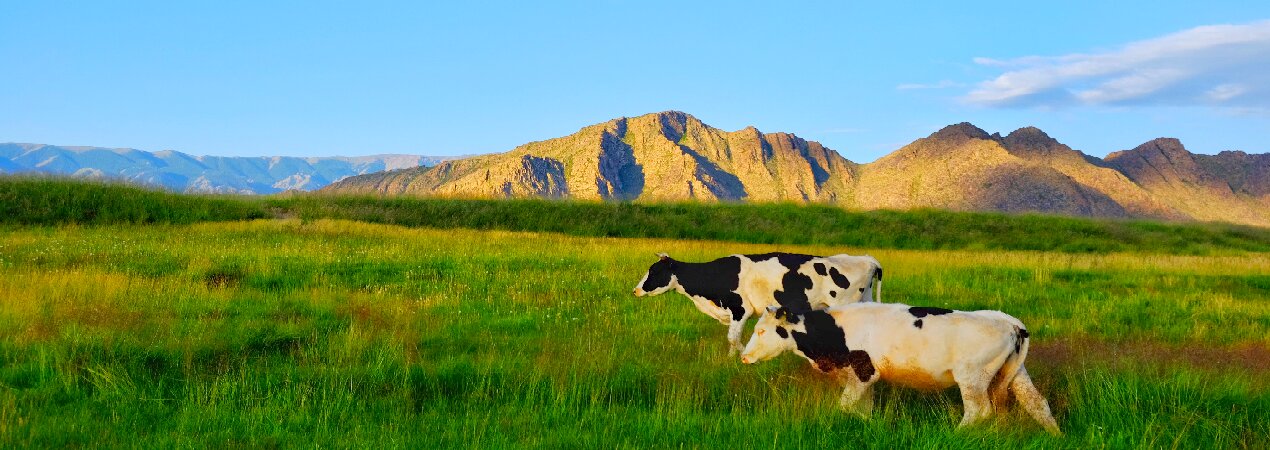
Hami, also known as "Kunmo", is located in the eastern part of Xinjiang. It serves as a vital gateway from Xinjiang to the mainland interior and stands as a unique, beautiful oasis in the region. As an important town on the ancient Silk Road, Hami boasts numerous cultural relics, attracting tourists from around the world. It has a typical temperate continental arid climate, characterized by low precipitation, abundant sunlight, large diurnal temperature variation, distinct four seasons and frequent wind and sand.
- English Name: Hami
- Chinese Name: 哈密(hā mì)
- Government: A prefecture-level city in Xinjiang Uygur Autonomous Region
- Location: East of Xinjiang, China (42.7893°N, 93.4305°E)
-
Area code & Zip Code:
Area Code: 0902; Zip Code: 839000 - Airports:Hami Yizhou Airport (HMI), Balikun Dahe Airport (BHK)
-
Railway Stations:
Hami Station, Hami North Station -
Suburban Districts:
Yizhou District, Barkol Kazakh Autonomous County, and Yiwu County - Population: about 673,383
Best Time to Visit Hami
Hami's summer is hot and dry. Winter is cold with heavy snowfalls, making it unsuitable for travel. Spring and autumn are pleasant and suitable for travel, but the temperature difference between morning and evening is large, so remember to bring warm clothing.
What to See
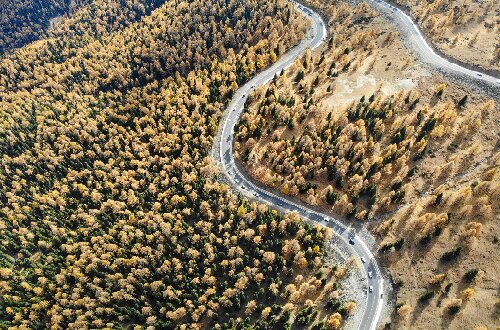 Tianshan Scenic Area
Tianshan Scenic Area1. Tianshan Scenic Area: The Hami Tianshan Scenic Area covers a total area of 200 square kilometers, integrating diverse natural landscapes such as snow-capped mountains, grasslands, forests and deserts. The core attractions include the Baishitou (White Stone) Scenic Area at an altitude of 2,126 meters, Songshutang (Pine Forest), which is famous for its lush pine forests, and Mingshashan (Singing Sand Mountain), which ranks first among China's four major singing sand mountains in terms of sand chirping.
2. Hami Hui Royal Palace: The Hami Hui Royal Palace was once a large-scale, magnificent and uniquely-styled palace building in Xinjiang, and was known as the "Little Forbidden City of the Western Regions." The current Hui Royal Palace scenic area is a reconstructed complex of ancient-style buildings. Here, visitors can experience the grandeur and exquisite craftsmanship of the former Hami Hui Royal Palace and learn about the history of Hami during the reign of the Hui Kings.
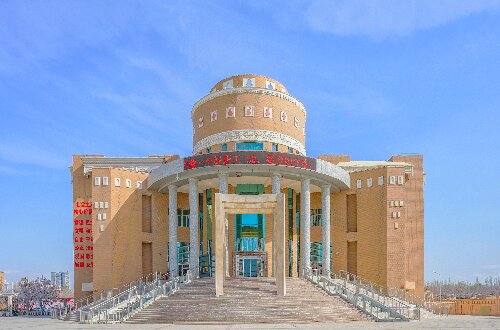 Hami Museum
Hami Museum3. Barkol Lake: The Barkol Lake Scenic Area is located in the western part of the Barkol Grassland, with an area of 119 square kilometers and a water surface altitude of 1,585 meters. It is a plateau saltwater lake and one of the four largest salt lakes in China. The Barkol Lake Scenic Area has become an important node landscape of the ancient Silk Road by building facilities such as a ring road around the lake, floating bridges and plank roads, and developing special tourism projects such as camel riding.
4. Hami Museum: The Hami Museum features a very unique design, exuding a rich national charm. It records the culture and history of a city and a nation.
Recommended attractions:
| Tianshan Scenic Area | Hami Hui Royal Palace | Hami Museum |
| Barkol Lake | Yiwu Populus Euphratica Forest | Altun Ancient Street |
How to Get There
The number of routes at Hami Yizhou Airport (HMI) reaches 14, with 15 navigable cities, including 7 cities outside Xinjiang, covering Beijing, Guangzhou, Zhengzhou, Xi'an, Chengdu, Chongqing and Lanzhou; and 8 cities within Xinjiang, covering Urumqi, Kashgar, Korla, Aksu, Yining, Bole, Alar and Tumshuke.
How far is Hami from Major Cities
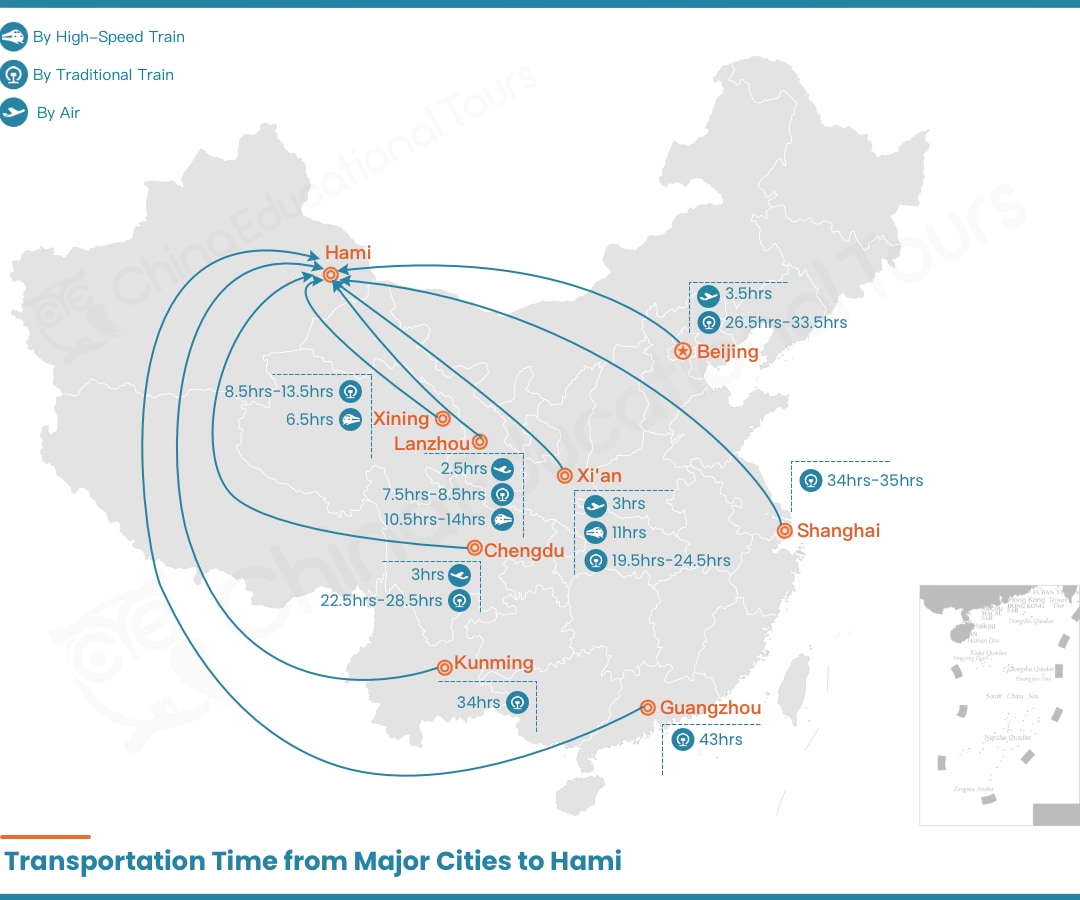
| Cities | Distance from Hami (km) | By Air to Hami | By High-Speed Railway to Hami | By Traditional Train to Hami |
|---|---|---|---|---|
| Beijing | 2201 | 3.5hrs | No direct high-speed trains | 26.5hrs-33.5hrs |
| Shanghai | 3364 | No direct flights | No direct high-speed trains | 34hrs-35hrs |
| Guangzhou | 3576 | No direct flights | No direct high-speed trains | 43hrs |
| Xining | 1169 | No direct flights | 6.5hrs-7.5hrs | 8.5hrs-13.5hrs |
| Xi'an | 1951 | 3hrs | 11hrs | 19.5hrs-24.5hrs |
| Chengdu | 2187 | 3hrs | No direct high-speed trains | 22.5hrs-28.5hrs |
| Kunming | 2989 | No direct flights | No direct high-speed trains | 34hrs |
| Lanzhou | 1331 | 2.5hrs | 7.5hrs-8.5hrs | 10.5hrs-14hrs |
How far is Hami from Other Xinjiang Cities
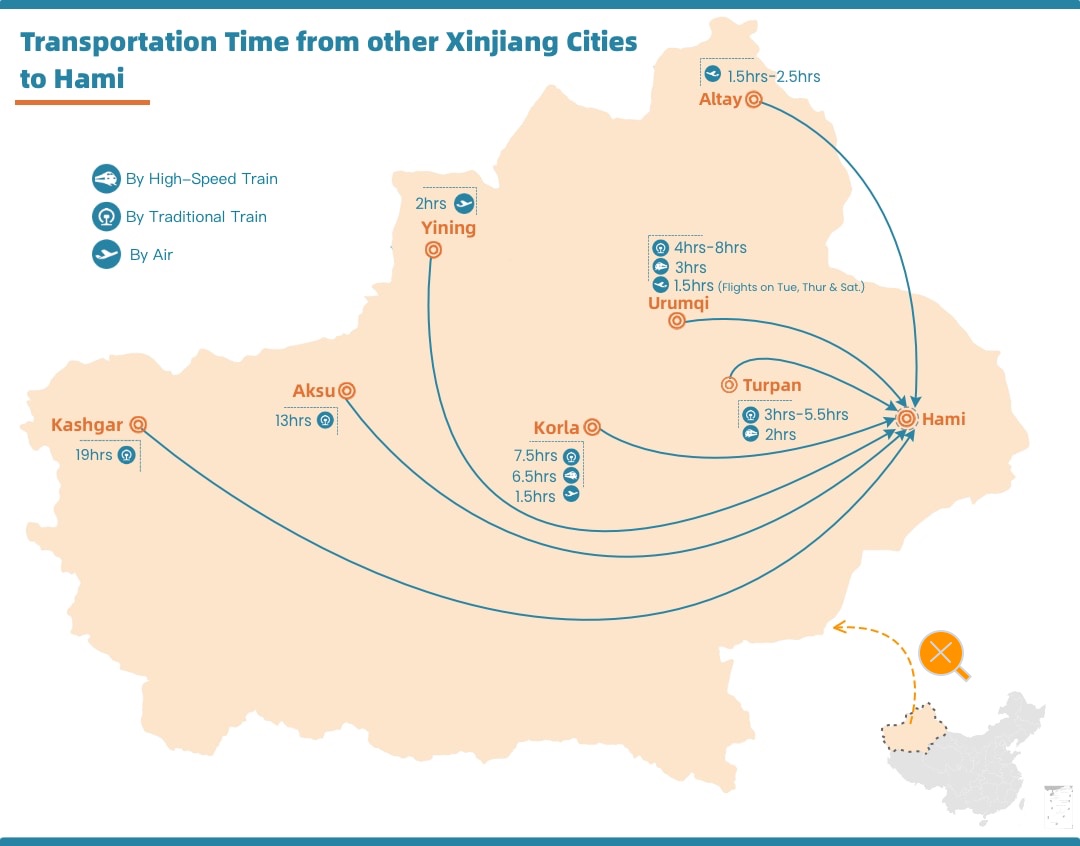
| Cities | Distance from Hami (km) | By Air to Hami | By High-Speed Railway to Hami | By Traditional Train to Hami |
|---|---|---|---|---|
| Kashgar | 1805 | No direct flights | No direct high-speed trains | 19hrs |
| Hotan | 1563 | No direct flights | No direct high-speed trains | No direct traditional trains |
| Aksu | 1346 | No direct flights | No direct high-speed trains | 13hrs |
| Urumqi | 595 | 1.5hrs (Flights on Tuesday, Thursday and Saturday) | 3hrs | 4hrs-8hrs |
| Turpan | 407 | No direct flights | 2hrs | 3hrs-5.5hrs |
| Korla | 811 | 1.5hrs | 6.5hrs | 7.5hrs |
| Altay | 1076 | 1.5hrs-2.5hrs | No direct high-speed trains | No direct traditional trains |
| Yi'ning | 1312 | 2hrs | No direct high-speed trains | No direct traditional trains |
Gourmet Food Recommendations
Mutton Stewed with Pancakes is a specialty of Hami. Thin pancakes are placed on top of the braised mutton, and the pot is covered for steaming. The cooked pancakes are then topped with the original mutton soup, making it very delicious.
Roasted Lamb is a specialty dish in Xinjiang. It uses high-quality sheep and is specially roasted. It is crispy on the outside and tender on the inside, and the aroma is fragrant.
Xinjiang Dapanji (Big Plate Chicken) originated in the early 1990s. It is mainly made of chicken and potato cubes, cooked with noodles. Xinjiang Dapanji is colorful, with spicy chicken and soft potatoes, and it is delicious.
Souvenir and Shopping
 Hami Melon
Hami MelonHami Melon: The Hami melons produced in Hami are the largest in China, with a crispy and sweet taste. The Hami melons grown in Hami contain 2-3 times more iron per 100 grams of melon pulp than chicken and 17 times more than that in milk. The vitamin content is 4-7 times higher than that in watermelons and 6 times higher than that in apples.
Xinjiang Carpet: Xinjiang is the birthplace of carpets. Xinjiang carpets are mostly made of pure wool, with a soft and comfortable texture and a beautiful and gorgeous appearance. They are essential daily necessities for the people of Xinjiang. Whether used to decorate houses or given as gifts to relatives and friends, they are excellent choices.
Hami Jujube: Due to the sufficient sunlight and large temperature difference between day and night in Xinjiang, the jujubes in Hami are high in sugar, excellent in taste, and rich in vitamin C.